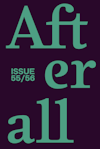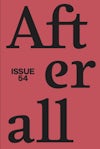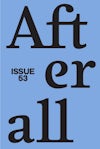
Issue 20
Spring 2009
Editors: Charle Esche, Thomas Lawson, Mark Lewis, Dieter Roelstraete, Pablo Lafuente, Melissa Gronlund, Stacey Allan.
Founding editors: Charles Esche, Mark Lewis.
Table of contents
Foreword
Contextual Essays
- Great Transformations: On the Spiritual in Art, Again – Dieter Roelstraete
- The Future Archaeology of Israel’s Colonisation – Sandi Hilal, Alessandro Petti & Eyal Weizman
Artists
Omer Fast
- From Homer to Omer Fast – Elisabeth Lebovici
- Omer Fast: When Images Lie… About the Fictionality of Documents – Maria Muhle
Enrico David
- Ode to the Chicken Man Gong – Jan Verwoert
- Enrico David: Publicly, Privately – Melissa Gronlund
Goshka Macuga
- Friendship of the Peoples: On the Work of Goshka Macuga – Grant Watson
- Knowing This… – Monika Szewczyk
Lothar Baumgarten
- Frontier Brokers
Events, Works, Exhibitons
- Totality: A Guided Tour – Julian Myers
- Workshop Defended Against Its Admirers – David Grubbs
- Role Refusal: On Louise Lawler’s Birdcalls – Stacey Allan
Foreword
Written by Carl Esche
Afterall journal celebrates its tenth anniversary in 2009. In the late 1990s, Mark Lewis and myself developed the idea to produce a publication that would occupy a double position in relation to artistic work…
Afterall journal celebrates its tenth anniversary in 2009. In the late 1990s, Mark Lewis and myself, as researchers at Central Saint Martins College of Art & Design in London, developed the idea to produce a publication that would occupy a double position in relation to artistic work, in some ways reflecting the different engagements each of us had with it. The journal was intended to offer a close reading of artworks, and at the same time relate them to the wider context from which they are born and upon which they act. Those ideas were brought to fruition in early 1999 with the first issue of the journal (issue 0), which featured the work Fiona Banner, Pavel Büchler, Jeremy Deller, Pierre Huyghe and Superflex. From its inception, Afterall was conceived as a critical organ that would, on the one hand, cover the individual artists (or artists’ collectives) in depth, with multiple texts on different aspects of their work, and, on the other, include articles looking at the conditions of art in the world, especially its possible socio-political function and capacity for commentary. We are today aware that, at the beginning, the journal was a decidedly Western European publication – the majority of the artists and articles reflected the conditions in the old imperial centres at the end of the millennium. The addition of CalArts as a co-publisher and Thomas Lawson as a co-editor in 2002 strengthened a North American focus that had been there to some extent from the start, and in 2007 MuHKA in Antwerp joined the editorial group, bringing Dieter Roelstraete into the editorial team, adding a third issue per year, and restructuring the journal while still remaining in sight of a engaged and critical view of art and its position in the world.
This approach has allowed Afterall journal to stray into unexpected territories at times. The first issue included a fascinating and important essay by Gertrud Sandqvist, titled ‘Art and Social Democracy’, on the problematic legacy of Swedish social democracy and its controlling impulses in relation to art, architecture and design; ten years later, issue 20 features an imaginative and significant proposal about the future of the Israeli settlements in occupied Palestine by Sandi Hilal, Alessandro Petti and Eyal Weizman. Nevertheless, our central focus has remained the production of art by individual artists and how their ability to speak about (their) life through art can offer ways of thinking about the world in a different way. The privileging of this direct relationship to art remains crucial if art is to have more than a merely instrumental role in understanding how abstract concepts such as economy, democracy or society function, and what effects they have on people’s lives.
Over the years, Afterall has adopted a steadily more critical tone, in a literal sense: we have not only covered issues and artists that we find important, but we have also touched upon subjects that feel in need of more thorough inspection, and have introduced a back section that looks at specific events, exhibitions and artworks that seemed relevant for our times. In the current issue, these include Julian Myers’s discussion of Harald Szeemann’s sprawling exhibition ‘Der Hang zum Gesamtkunstwerk’ (1983), a diagnosis of a failed European drive towards utopia figured in aesthetic terms; or Stacey Allan’s analysis of Louise Lawler’s Birdcalls (1972/81), a work that reminds us of the unresolved issues of gender equality that have been a battleground for art at least since the early 1970s. These are accompanied by three artists whose practices intersect with other modes of image-making: Goshka Macuga’s research and ‘curatorial’ strategies, Enrico David’s craft and design work, and Lothar Baumgarten’s investigation on language. Perhaps more importantly, the lines of enquiry of this issue run both into the future – as in Hilal, Petti and Weizman’s contribution – and into the past, in Omer Fast’s investigation of the technical means of historical representation, Baumgarten’s account of excluded histories and Dieter Roelstraete’s discussion of the renewed importance of magic and religion in his opening essay.
Purchase
The publication is available for purchase. If you would like specific articles only, it is also available individually and to be downloaded as PDFs.
Purchase full publication
Buy via University of Chicago Press
Buy via Central Books
Purchase individual articles
Buy via University of Chicago Press



